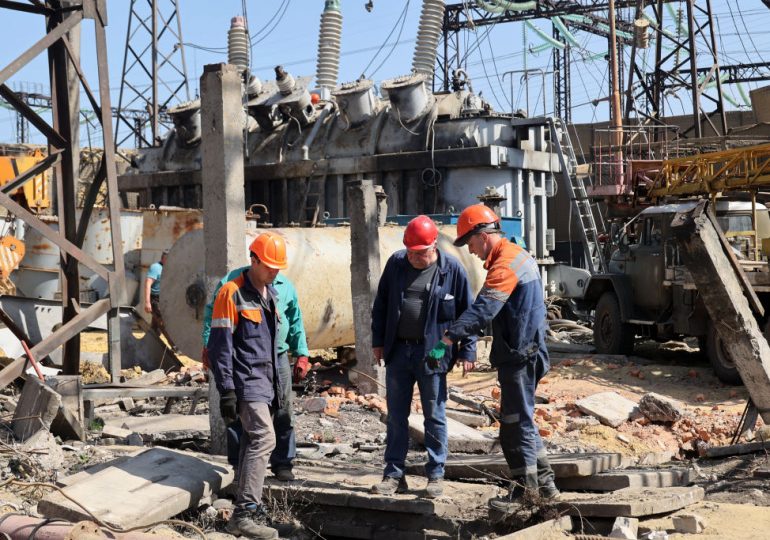As part of its hybrid war strategy, Russia has been targeting Ukrainian grain silos, schools, hospitals, power plants, and more for two and a half years. Given the Kremlin’s failure to overrun Ukraine militarily, it has increasingly turned instead to making the country uninhabitable. This strategy isn’t new. But 2024 has seen wave after wave of basic infrastructure hit with previously unknown accuracy and ferocity. The biggest target is now the country’s power sector, and specifically, its ability to generate electricity.
[time-brightcove not-tgx=”true”]
Between 2022 and 2024, Russia targeted approximately 50% of Ukraine’s energy infrastructure, including forcing the Zaporizhzhya Nuclear Power plant offline with repeated strikes, and the bombing of the Kakhovka Hydroelectric Dam. Transmission lines and electrical substations were also often hit. But Ukrainian engineering and power line teams had proved extremely diligent, fast, and adept at repairing them. Difficulty in procuring replacement autotransformers sometimes extended blackouts, but Ukraine bounced back relatively quickly and survived both winter 2022-2023 and 2023-2024. This time is different.
Some 60% of Ukraine’s power generation has been knocked out, as Russian precision bombs, drone strikes, and rocket attacks increasingly home in on power plants and energy infrastructure. The country is now suffering the worst rolling blackouts since Russia launched its full-scale invasion in February 2022.
Ukraine’s ability to regenerate and rebuild has now been overwhelmed, at least for the immediate future. Over 9 gigawatts of power generation alone has been taken out just since March. More hydroelectric plants have been destroyed, including the Dnipro station, the largest that was still working. Solar power facilities, too. Every single one of the thermal—coal and natural gas burning—plants has been hit, and of the original 13 no more than two are still operational. DTEK, Ukraine’s largest private power company, has lost 90% of its generation capacity. The current national power deficit is approximately 35%.
Four months of brutal strikes on Ukraine’s energy infrastructure have done so much damage that even in Kyiv there are only 10 hours of electricity per day—and just four for some other cities. It will take years to rebuild. Come winter, this situation will get much worse. DTEK executives estimate that winter blackouts could reach 20 hours per day. And several of the power plants that have been destroyed were combined electricity and heating facilities, so it will not only be dark but also very cold in the middle of Ukraine’s famously harsh winters. People will almost certainly die from cold, or lack of access to care.
There are numerous proposals and ideas about how to help Ukraine survive this winter. Ukrenergo, the national electricity grid company, is working in both the public and private sectors to get new generation and storage capacity online, with a strong priority of developing distributed power instead of centralized facilities. Ukraine is already importing electricity from Poland and other neighboring countries, but imports cannot make up enough of the difference and are expensive. Rebuilding thermal power plants makes little sense in the long run, both because of Ukraine’s climate change commitments and because gas and coal have become scarcer under Russian sanctions, so renewables are the focus in the near future and nuclear power in the long term. Immediately, private generators are humming all over the country, for those who can afford the units and the diesel to keep them running.
While these possible solutions are gradually taking shape, Ukraine exists in a partial darkness and state of dysfunction that is gradually undermining its stamina. People’s ability to work, to bank, to get medical treatment, to use their phones or internet, and so on, has been hammered by the lack of power. Schools cannot operate normally. Nor can businesses. This in turn means less money for individuals, and also less tax revenues with which to pay for the government and the war effort. And many may finally make the difficult decision to leave their country because life, already no walk in the park, has become even more difficult.
But this bleakness does not mean Ukraine’s supporters should count it out. Nor should they stop supporting Kyiv, even as global attention has shifted to Israel’s expanding war and the U.S. presidential election. Friendly countries are still looking for much-needed power grid replacement parts to ship to Ukraine. Each shipment of new military support, now including F-16 fighter jets, helps Ukraine survive. Giving Ukraine air defense systems or allowing Kyiv to take offensive measures against Russia could mean a more decisive defense posture. At the very least, the West should help Ukraine win enough of its country back to strengthen its negotiating position against Russia should real peace talks ever take place.
While Ukraine waits for more help to arrive, perhaps its most important defense against Russia is that its people somehow remain optimistic. Despite the brutality of war, and facing the looming doom of winter with major electricity shortages, only 44% of citizens want to negotiate with Russia. As many as 88% believe Ukraine will still win the war and 80% consider the country’s future to be promising. Their optimism should not make Ukraine’s backers complacent. As many Ukrainians are quick to explain, they are a resilient people. They have to be.
Leave a comment








